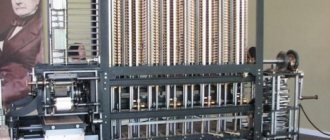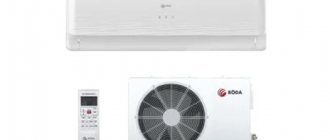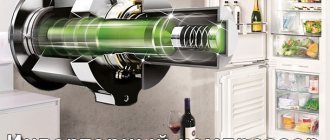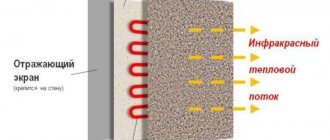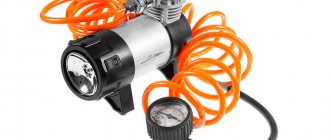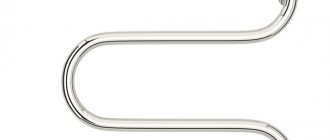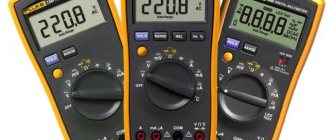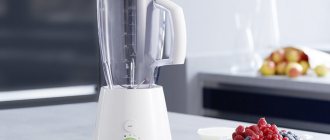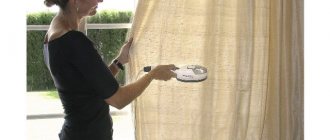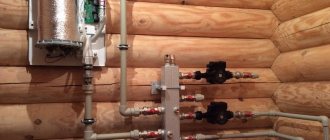Principle of operation
The basis of any air conditioner is the compressor, since it is responsible for moving the refrigerant through the main pipes and devices. To understand what has changed with the advent of inverter air conditioners, you need to compare the operating principle of the compressor of each of these systems.
Operation of a standard split system
When the air conditioner is turned on without an inverter, the indoor module sensor monitors the temperature in the room. As soon as it reaches the values you set, the relay is activated and gives the command to turn on the compressor.
The installation, in turn, begins to work at full capacity, quickly bringing coolness. When certain indicators on the thermometer are reached, it turns off.
When the temperature rises to the desired mark on the thermometer, the sensor is triggered again, gives a command to the relay, which turns on the compressor motor and the cycle repeats.
Inverter air conditioner
Operation of inverter air conditioner
Let's consider how an inverter air conditioner works? When the split system is turned on, the sensor of the indoor unit also monitors the temperature in the room and “compares” it with the configured values. When the set temperature is reached, the temperature sensor is activated and transmits a command to the relay and to the compressor motor.
The unit also starts working at 100% load, quickly cools the air in the room, but then does not turn off completely. An air conditioning device with an inverter does not need to re-cool the entire volume of air in the room each time; it only blows out a certain amount to create the desired temperature.
Of course, this ability of the climate control device is an advantage, since energy costs are reduced, drafts disappear, and the noise level is greatly reduced. An undoubted advantage of inverter air conditioners is that the compressor continues to constantly operate in a given temperature range at 10–95% of its capacity.
Comparison of inverter and conventional devices
When choosing between classical and inverter type systems, it is necessary to rely on a clear idea of the desired result, an understanding of the operating principles of such air conditioners and the technical feasibility of their use.
The principle of operation of different air conditioning systems
Let's consider the principle of operation of an ordinary air conditioner in the mode of maintaining a given air temperature in a certain range.
So, when working for cooling, the device operates until the minimum temperature range is reached, after which it turns off. As soon as the temperature sensor detects that the temperature has reached the upper limit of the range, the air conditioner turns on.
The temperature range for all classic-type devices is from three to five degrees, otherwise frequent switching on and off will quickly damage it. Simpler and cheaper systems are turned on manually or by timer.
When the required temperature is reached, the inverter system begins to operate in its support mode. This is expressed in a decrease in the number of compressor engine speeds that pump freon to the evaporator, which leads to a decrease in temperature transfer. Read about how to refill the coolant into the air conditioning system in this material.
Inverter systems, unlike “on/off” models, operate continuously and provide a smaller range of temperature fluctuations. Their work is almost invisible to the user
Thus, the principle of operation of ordinary air conditioners is alternating operation with constant power. And inverter devices operate in constant mode with variable power.
For the consumer this is expressed as follows:
- the flow of cold air when cooling or warm air when heating is more powerful in conventional systems during their operation, which can cause discomfort;
- inverter systems maintain the set temperature more evenly;
- Conventional systems make more noise, especially when turning on and off.
Therefore, from the standpoint of creating a suitable indoor microclimate, the new type of air conditioners clearly outperforms their classic predecessors.
Pros and cons of the technical plan
Like any innovation, inverter systems have positive and negative technical aspects compared to models made using previous technology.
One of the main criteria by which the user chooses equipment is the cost of both the device itself and its maintenance and repair. As a rule, recently launched products have a price significantly higher than that of outdated models. A similar situation has developed in the air conditioner market.
The recommended retail price for Toshiba air conditioners shows that the presence of an inverter increases the price of a household model from 7 to 19 thousand rubles
In addition, the cost of service, repair or replacement of spare parts for inverter systems is much higher. The price of the frequency converter electronic board costs almost the same as the other components of the device.
There are practically no third-party parts on the market, while for older models there is a large selection of compatible components.
The second problem is that both monoblock devices and split systems of the new inverter type are complex electronic devices. Therefore, despite the presence of integrated safety components, it is necessary to ensure a high-quality power supply to avoid damage.
The third problem is the risk of failure of expensive electronics. Even with normal power supply, aging and loss of volume in capacitors, thermal breakdown of power elements and other problems typical of boards can occur over time.
Modern inverter devices, unlike their classic predecessors, have complex electronics, so they must be handled carefully
In terms of energy savings, there is no clear answer. As manufacturers say, during normal operation, inverter systems are more economical than classic ones, which at startup consume a lot of resources with low efficiency. This is true, but the savings are not so great that we can talk about quickly compensating for the price difference.
If we compare the operation of models at a constant maximum power, then with the same technical indicators, the new models are inferior to the classic ones due to the fact that thermal energy is released during double current conversion. Therefore, this mode of using inverter systems is impractical.
But from the point of view of the device’s impact on the electrical network, inverter devices are definitely better. They consume electricity evenly, so the maximum load is less than with a classic type air conditioner.
In addition, every time at the start, a peak load occurs and a voltage drop occurs. If the cross-section of the power cables is insufficient, this is especially noticeable and negatively affects the quality and safety of the operation of other devices in the circuit.
Image gallery
Photo from
Two inverter air conditioner units
Equipment with virtually silent operation
Floor standing indoor unit
Unit with economical energy consumption
Over time, the shortcomings of the new technology will be eliminated or will have to be accepted due to the significant improvement in comfort compared to the use of previous generation devices.
We also recommend reading the article about the most common malfunctions of split systems and how to eliminate them.
The standard noise filter on the electronic board of an inverter cooling system includes high-voltage protection varistors, noise-filtering capacitors and chokes.
The advantage of inverter split systems compared to conventional ones
When choosing an inverter or a conventional air conditioner, you need to fully understand the difference between them.
The motor of the inverter air conditioner adapts to the impulsive temperature changes in the room and automatically selects the optimal power range with the lowest energy consumption. In addition, the speed of the fan impeller changes, which significantly reduces the noise level and creates more comfortable operation of the device.
To determine which air conditioner is better - inverter or conventional, you need to understand that the absence of frequent engine starts for the compressor extends the life of this device. On average, it can last 15-18 years, when similar non-inverter units work, according to statistics, for 6-8 years.
These inverter air conditioners are differentiated by minimum, medium and high power. Unlike non-inverter devices, the maximum performance is a certain power reserve, usually about 20%. Accordingly, due to this, the air conditioner will quickly cope with achieving the desired cooling or heating mode in the room.
Pros and cons of using inverter systems
Having figured out what the model name “inverter split system” means, it’s time to talk about the pros and cons of the units. First, about the bonuses - even after a short period of use, users manage to appreciate the benefits of such technology.
- The difference between an inverter air conditioner and a conventional one is that it has no operating restrictions (for a traditional device this is no more than 8 hours per day).
- You don't have to worry about network congestion. And their absence means energy savings in the range from 30 to 50%. When paying utility bills, the difference is significant.
- The device can be called economical - there are no “idle loads”.
- The set temperature is precisely maintained.
- The effect of the air flow also becomes more comfortable: during conditioning, a soft flow of 12-15 °C will be released. This reduces the likelihood of getting sick (as happens when using a regular analogue).
- The reduced noise level (only 19-23 dB) allows you to operate such a device even at night (in comparison, for the conventional version it is 30-32 dB).
- Long service.
- Finally, a device with an inverter will help heat the room even at temperatures reaching -25 degrees.
Inverter air conditioners also have certain disadvantages.
- The “highlight” in the form of soft thermoregulation is not suitable for every room. What is ideal for bedrooms and children's rooms is absolutely ineffective at creating a comfortable atmosphere in offices and other public places (people constantly enter and exit, close and open windows).
- You should not install an inverter air conditioner in the kitchen; its operation will be disrupted by the heat from the kettle or stove. Climate control technology simply cannot cope with such constant temperature changes.
- The maintainability of the devices does not have the last word. For example, the types of inverter and non-inverter compressors are absolutely the same, but if the electronic board fails, replacing it will cost at least 10,000 rubles. And spare parts cannot be found widely.
- For economic reasons, it is not profitable to operate such a unit in a dacha that is rarely visited by residents.
- Finally, the high cost of the device makes it difficult for anyone to purchase it.
In which rooms is it better to install inverter equipment?
Due to the low noise level of inverter air conditioners, the indoor unit can be installed in the bedroom, living room and other rooms where comfort and silence are important. It is advisable that there are no drafts or strong air currents in the room, as this will interfere with the operation of the device. In the kitchen, due to a sharp temperature change, you should not install an inverter, as this will lead to operation at high power. In offices, gyms, restaurants and other public places, installing an inverter will not be justified, since, due to the operating principle, it will not be able to show high efficiency. It will take a long time to cool and heat the room. In technical and industrial premises, you can install a conventional split system for the same reasons.
How to choose
To solve the issue of air conditioning an apartment or house, you need to competently approach the choice of climate control equipment. The main thing you should pay attention to is the manufacturer. We do not recommend buying cheap models, as they will quickly fail and require repairs. DANTEX is a reliable manufacturer of inverter air conditioners with service in Moscow. The product line is represented by models with different power levels. They are suitable for both small rooms and spacious rooms with large crowds of people. Select the power of the climate control equipment depending on the area of the room. Air conditioners for home use are divided into 4 types:
- low productivity - up to 2.5 kW;
- average productivity - up to 3.5 kW;
- high productivity - up to 4.5 kW;
- maximum productivity - from 4.5 kW.
For a room of less than 18 square meters, low-performance equipment is sufficient. For rooms with an area of 20-25 square meters, a medium-power system is suitable. Calculating productivity is easy. For every 10 square meters with a standard ceiling height (2.70 meters), 1 kW of cooling capacity will be required. For rooms located on the sunny side - 1.5 kW. Manufacturers often label air conditioners as 5, 7, 9. Systems owe this marking to the British thermal unit BTU. For example, 5 is a low-performance system, 7 is medium, and so on. Think about what is important to you in the system - regular room conditioning or additional air purification, ionization, and so on. Inverter models are equipped with many additional functions: ionization, economical mode, self-cleaning, antibacterial filter, ventilation, self-diagnosis, motion sensor and much more. When choosing an inverter system, consider the dimensions of the equipment. This is especially true for owners of small apartments. However, you should not choose the smallest models. The optimal dimensions for an indoor unit of medium power are about 800 mm in length and 270 mm in width. With smaller dimensions you will not get the declared power. Climate control equipment will not be able to cool a room larger than 25 square meters. The materials from which the air conditioner is made play an important role. The plastic should not be too thin or flexible. Color: bright white. If other shades are present, the quality of the materials is probably low. If you still have questions regarding the purchase of an inverter air conditioner, consult a DANTEX company manager.
Influence of the inverter on noise level and power consumption
Inverter split systems work differently than standard air conditioners. The compressor is powered by a DC motor. The control module in split systems converts direct current into alternating current of a given frequency. This process is called inversion.
This transformation allows you to change the rotation speed of the compressor engine over a wide range, and accordingly, the creation of coolness and warmth. The power of the motor is regulated by simply changing the voltage: more voltage means the rotation of the motor shaft increases.
Accordingly, the movement of refrigerant from the compressor accelerates. And vice versa, the voltage decreases - the engine speed decreases, and the speed of freon through the tubes decreases. The standard device uses a compressor with an AC motor, and its power is regulated only by turning the motor on or off.
It turns out that the inverter device is designed to change the standard frequency of the electrical network. The device has an integrated control board, through which the operation of the device is regulated. It is located in the outdoor module and regulates the number of times the device is turned on.
Consequently, for air conditioners with inverters, the compressor moves the refrigerant whenever the split system is turned on in cooling mode (at the same time, its speed is either higher or lower). This has three important advantages:
- The engine has no starting torque.
- Possibility of smooth regulation of cool air movement.
- The inverter air conditioner in the apartment operates in the created mode.
As a result of the first advantage, the split system consumes approximately 20-25% less electricity than a classic climate control device. The second point indicates that the compressor of an inverter air conditioner operates in the range of 0.5-1˚C degrees (and for standard split systems the range is 1-5˚C).
The third advantage means quieter operation of the air conditioner. Thanks to this mode, the air conditioner operates silently and is often used in bedrooms at night. At the same time, it switches to an economical mode with slow rotation of the fan impeller. Inverter wall-mounted air conditioners from Hitachi are especially suitable for this setting.
Description of equipment
First of all, you need to decide what an inverter air conditioner means. A distinctive feature of the devices is their power part, which allows you to increase and decrease the frequency of the electric current, while ensuring stable operation of the equipment.
Automatic control monitors all parameters, simultaneously ensuring a reduction in energy consumption for heating and cooling the room.
When turned on, such an inverter air conditioner immediately operates at maximum, and as soon as the temperature in the room is lowered to the values specified by the user, the power of the equipment drops to a minimum, while the equipment does not turn off completely. This operating principle distinguishes inverter climate control equipment from standard split systems and air conditioners.
The design of the inverter air conditioner consists of the following elements:
- inverter;
- power unit;
- generator;
- Control block;
- numerous remote sensors;
- compressor.
Today on sale you can choose various modifications of air conditioners that differ in power ratings. These can be small installations, which will be an excellent option for owners of small apartments. You can also choose powerful, versatile equipment that can cope with cooling and heating air in a room with an area of 300-500 square meters or more.
Modern installations are fully controlled by automation, which receives data from numerous external sensors, and at their command, the intensity of the equipment’s operation increases or decreases. In comparison with classic split systems, only due to the presence of an inverter and control automation, energy savings of 20-30% are achieved. This technique is efficient in use, allowing you to heat or cool a large room in the shortest possible time.
Advantages and disadvantages of inverter split systems compared to conventional ones
Of course, such climate control equipment has its pros and cons. The main distinguishing advantage of inverter air conditioners is that they have no restrictions during operation. Traditional devices are produced by manufacturers with a resolution of no more than 8 hours a day.
In addition, an air conditioner with an inverter has the following advantages:
Smooth operation of the device. There will be no power overloads while using this device. After all, as you know, at the moment the engine starts, a peak load is created for the entire network in the house. Accordingly, their absence provides energy savings of up to 40%, so the climate control device is considered an economical device.
Small temperature range. This type of air conditioner precisely maintains the set temperature. Comfortable air flow: during operation, a soft air flow comes out strictly within the specified temperature range. This largely limits the likelihood of catching colds (as happens when using a conventional analogue).
The minimum noise level (18-22 dB) allows you to use this device even at night (for an ordinary device, the noise level is 30-33 dB).
Long service life.
Heating of premises in the cold season. The ability of an inverter air conditioner to heat a room at street temperatures reaching -25 degrees.
There are also disadvantages to inverter air conditioners:
- The electronic circuits of these devices react to voltage changes and can burn out during sudden surges.
- Soft thermoregulation is not suitable for all rooms. They are good for bedrooms and children's rooms, but are not suitable for hotels, offices, that is, where doors are constantly opened. And since the air exchange changes, the air conditioner is simply not able to constantly regulate in the desired mode.
- High price. Perhaps the most powerful counterargument. Not every average person can afford such a purchase.
We are looking for real pros and cons
Let's list the advantages of coolers with inverters, declared by sellers and manufacturers of climate control equipment:
- efficiency 30-60% compared to conventional “splits”;
- reliability, long service life;
- reduced noise level during operation;
- more accurate maintenance of air temperature;
- the ability to heat a house at negative street temperatures of minus 15 °C.
Comment. You need to understand that manufacturers and traders of refrigeration equipment often exaggerate the merits of their products. Example of an advertisement: the lifespan of a conventional cooler is 8-10 years, and that of an inverter cooler is as much as 15 years. The goal is clear: the consumer must believe and buy a more expensive air conditioner for an apartment or private house.
We will analyze the positive aspects separately, and at the end we will lay out the real disadvantages of inverters. First, we suggest you watch the video:
Cost-effectiveness is a relative concept
Air conditioners with variable compressor shaft speed really save energy due to the absence of starting currents and a smooth decrease in performance. It is not for nothing that such a technique was invented in Japan and has found wide application in Europe, where the cost of electricity is quite high.
The operating conditions for climate control household appliances in post-Soviet countries differ from those in Western European countries. Savings from using inverter air conditioners are small for the following reasons:
- The hot season lasts relatively short, and the price of 1 kW of electricity is much lower than European tariffs. If the kilowatts saved during the year are converted into monetary equivalent, the amount will not impress you.
- The inverter also consumes extra energy. Some parts become very hot during operation, converting electricity into heat. Otherwise, why are aluminum heat sinks installed on the board?
- The amount of energy savings depends greatly on the type of space being cooled. The effectiveness of the device is clearly visible in the bedroom, small living room or children's room. Another thing is an office, where employees constantly open windows and entrance doors, work with office equipment, and so on.
Note. Many online resources talk about the efficiency of inverter coolers using the example of a moving car, giving the corresponding picture. Such schemes give a distorted idea of the energy consumption of a frequency converter operating in tandem with a compressor.
Intermediate output. A smooth increase and decrease in power really gives results - less electricity is consumed (the delta compared to a “non-inverter” will be 15-30%). But the effect is offset by low tariffs, a short hot season and the consumption of the inverter unit itself. Against the backdrop of the price of equipment and spare parts, energy saving becomes illusory.
Scheme of operation algorithms for various air conditioners
Reliability and service life of units
In order not to take up the reader’s precious time, we will present the analysis of these advantages in the form of brief theses:
- The most vulnerable unit of a refrigeration machine is the compressor. In second place is electronics.
- On the one hand, the lack of starts/stops increases the life of the inverter supercharger. On the other hand, the service life is reduced due to continuous operation.
- Practice shows: new branded inverters (not cheap Chinese ones) really last a long time. Only the reason is different - the introduction of modern technologies, for example, scroll and two-rotor compressors with DC electric motors.
- Voltage surges in our network can cause damage to any electronics, regardless of the type of air conditioner. Repairing the inverter will cost much more.
- If the cooler has not been serviced for years, is operated with a lack of freon or clogged heat exchangers, the result will be the same - a breakdown of the supercharger. The presence of a frequency converter does not matter.
Diagram of the operation of a rotary compressor installed in various types of split systems
Hence the conclusion: a standard “split” is not inferior to an inverter in terms of reliability and durability, and if the electronics are replaced, it will win in terms of the price of parts. We are talking about high-quality equipment from proven brands - Daikin, Mitsubishi, York and the like. There is no point in comparing Chinese products.
Are inverters noisy?
In any air conditioner there are three units that make noise:
- compressor;
- axial fan of the external module;
- turbine fan of the indoor unit.
The first two elements are placed outside the home (excluding window and mobile versions of air conditioners). In addition, modern inverter split systems are equipped with low-noise blowers; they are practically inaudible behind the wall. The axial impeller starts periodically and does not bother residents with extraneous sounds.
The turbine of the internal split module is clearly noisy. The sound level depends only on its design, the inverter does not play a role. But the latest generation machines still have an advantage - they get advanced developments, for example, an impeller with a special blade profile. This is how the myth about the noiselessness of inverter models arises.
Accurate temperature control
A cooler equipped with a frequency converter more accurately maintains the set temperature, this is an indisputable fact. The problem is different: sellers associate this feature with preserving the health of residents, although in reality we are talking about a comfortable stay inside the room. Precisely maintaining the air temperature eliminates the feeling of stuffiness and cold when the standard split model is turned off.
Reference. In the vast majority of cases, people catch colds from sudden climate change. Example: while actively moving along the street in the middle of summer, you enter a room with a temperature of +21 °C. A hot body cools down sharply, which often causes a cold.
We will again describe heating using an inverter briefly:
- In the previous generation of installations, street blocks froze and oil froze in the compressor crankcase.
- Inverters do not have this problem - the units continue to operate down to minus 15 degrees.
- With a reverse cycle, the efficiency of heat transfer decreases sharply along with the outside air temperature. Inverter devices are capable of working, but in severe frost they heat the room rather weakly.
- How it looks in practice: the internal turbine turns on much less frequently, and the breaks between starts increase. The air stream is barely warm.
Conclusion: during the cold period, all air conditioners are able to effectively heat the air as long as it is 0...+5 °C outside. In cold weather, the heating intensity decreases noticeably, although the inverter can physically function. The device simply does not have enough heat exchange surface area due to the small size of the condenser.
The photo shows external modules of a Mitsubishi Zubadan inverter heat pump. The dimensions are very different from the blocks of a household split system
Reference. In air-to-air or air-to-water heat pumps, which are descendants of split systems, the issue of efficiency is resolved by increasing the size of external heat exchangers.
Briefly about the disadvantages
Having analyzed the real advantages of inverter air conditioning units, we can talk about the following disadvantages:
- high initial price of equipment, on average 30% more than “non-inverter” devices;
- expensive repair of electronic components;
- questionable reliability of frequency converters - boards often become unusable due to power surges.
The advantages of inverters over classical models in our conditions are minimal. A noticeable reduction in electricity consumption is observed with year-round use (heating + cooling) in living rooms.
Tips for choosing a model
A split system is an excellent option to get rid of the summer heat and create a comfortable microclimate in your home at any time of the year. In the climate control equipment market, the sale of inverter air conditioners from different manufacturers has been established.
In order not to make a mistake when choosing this expensive air conditioner, you need to know the parameters of these devices. First of all, you need to pay attention, of course, to the power and noiselessness of the unit.
Silence. In the passport for the device, as a rule, this parameter is indicated for the indoor and outdoor modules. Of course, the noise indicator of the first block is more significant, since it is located indoors. In this case, noiselessness is expressed in decibels and should be shown on the air conditioner plate at a level of 22-24 dB.
This noise is almost unnoticeable during the daytime. A split system, by definition, produces less noise than any other system consisting of two blocks. At night, there are fewer extraneous sounds and the noise from the air conditioner is more noticeable.
Therefore, when choosing a model for the bedroom, it is recommended to choose it with a “night mode”. This function makes it possible to reduce noise on some split systems to 18-21 dB.
Power. When choosing performance, these devices have their own peculiarity. Let’s say the device has a power of 2 kW, but you should not accept this figure as valid. The required performance and the power consumed are different characteristics.
Typically, the power to create coolness is about three times greater than consumed. This means that if the calculation results in a power of 2 kW, then the power consumption will be about 700 W. Excessive productivity is also undesirable, as this will lead to unnecessary energy consumption and financial costs.
Location. When choosing which inverter split system or monoblock to choose, the characteristics of the room are of great importance. The outdoor unit can be mounted on a wall, roof or foundation. And the internal module is placed on the floor, wall and even behind suspended ceilings. Where it is impossible to install a wall-mounted unit, you can make your choice on a mobile (floor-standing) inverter air conditioner.
Installation. When installing such expensive inverter air conditioner models, you should pay due attention to the choice of installers. It is recommended to contact the same company (if possible) from which you purchased this unit, since they bear full responsibility for the installation and operation of this air conditioner.
Additional functions.
The efficiency of operation is greatly influenced by many additional modes that are equipped with current inverter devices:
- Heating the apartment during the off-season period.
- Air purification.
- Air ionization.
- Room ventilation.
When choosing a split system based on modes, you need to understand what this or that function gives you. Remember that the more a device has any additional modes, the more expensive it will be.
Split systems and monoblocks
Until the recent past, the most popular were split systems consisting of two units: an external one, responsible for taking in fresh air from the street, and an internal one, which included built-in automation and provided cooling or heating of the room. However, today an increasing number of homeowners are paying attention to monoblocks, which are distinguished by their functionality and versatility of use, and their installation in an apartment or private house does not present any difficulty.
Modern monoblocks are equipped with filtration, ozonation and air humidification systems, which allows for the highest possible comfort and coziness in the home. In this case, there is no need to install two blocks and lay a main line, which leads to a significant increase in installation costs. Thanks to the use of inverter technology, the size of such equipment has been significantly reduced, it operates with minimal noise, and is capable of cooling or heating the air in a large room, apartment, or private house in the shortest possible time.
We recommend that you read: Air conditioner pump
The advantages of split systems include their high power and excellent reliability. If you need to select inverter air conditioners for a house with an area of 200-300 square meters, then there are currently no alternatives to such equipment. You just need to competently carry out all installation work , including laying a short path from the outdoor to the indoor unit, and subsequently perform timely and correct maintenance of the equipment. The latter will ensure trouble-free operation of the air conditioner, their reliability and the absence of any critical breakdowns.
Preventative work
If you use the air conditioner for a long time, dust and grease accumulate on its elements. This applies to the heatsink, filters, fans and other parts inside the case. As a result, microorganisms harmful to human health are formed in these places and are carried along with the air.
Dirt deposits negatively affect the operation of all equipment, which requires cleaning the components and performing basic preventative repairs of the device. If you do not do this, then after some time the air exchange will noticeably deteriorate and the load on the device and the electrical network will increase.
In addition, fluff and leaves collect on the body of the outdoor unit, which changes the operation of the heat exchanger and worsens the refrigerant conversion procedure. Thus, when servicing such climate control equipment, you can clean or change dirty filters, a condenser (heat exchanger) from dust and fluff, and a fan from fat deposits.
All these works are specified in the instructions for this device. The rest of the preventive maintenance should be left to the specialists from the service center. In order to fully complete the scope of work, you must have experience in maintenance, as well as special tools and equipment.
To avoid incorrect maintenance and possible health risks, the best option is to entrust this process to professionals. This will save you energy, time and protect you from danger.
The working principle of a conventional air conditioner
The operating principle of conventional air conditioning devices is based on a well-known physical phenomenon - the ability of substances to absorb heat during evaporation and release it during condensation. The main thing to know is that air conditioners produce neither heat nor cold. Their purpose is only to transfer air masses in a circle - from indoors to outdoors (to the external part of the air conditioner) and vice versa.
For example, when the cooling mode is turned on, the air conditioning device works to remove heat from the room air. That is, in fact, to remove the energy that was released during the cooling process. That is why air conditioners consist of external and external components. Freon, which is a special refrigerant, is predominantly used as an energy carrier in air conditioning devices.
The whole essence of the device’s operation comes down to the fact that after setting a certain temperature on its temperature sensor, the air conditioner begins to function until it is reached. After this, it goes into sleep mode and only after a change in temperature indicators - a drop or an increase - does it turn on again. The spread of temperature indicators, in this case, can be up to 5 degrees.
For example, if you want to have a room temperature of 20 degrees, then the air conditioner can exit the “sleep” mode both at a temperature of +21 and at +25. It all depends on the specific model of the air conditioning device.
We recommend that you read: Split air conditioning system
Choosing the best model
Many buyers are interested in the question of which split system to choose. The ever-increasing demand for accurate and economical air conditioners has led to an expanded range of these devices from manufacturers of climate control equipment. The variety of brands makes it difficult for buyers to choose, so it is necessary to describe such models in more detail.
Daikin. This popular company makes products that are trustworthy. Although the devices of this company have a laconic design, at the same time they have a variety of modes and this is their main advantage.
Mitsubishi. Mitsubishi products do not need advertising - split systems with an inverter from this manufacturer will be an excellent choice for buyers. They have a stylish design and impeccable build quality.
Panasonic. The devices of this company show the quality of premium equipment. With wide functionality, ultra-reliable devices are suitable for various categories of buyers.
Toshiba. This company was the first to develop and introduce the production of modern air conditioners using the inversion principle, which means that these products deserve special treatment from consumers.
Hitachi. Another company well known to consumers. It produces products for both household use and powerful devices for production.
TOP 5 best inverter air conditioners
The user rating of modern split systems with electronically controlled compressor operation was compiled based on customer reviews on visited forums.
Mitsubishi Electric MSZ-LN35VG
Wall-mounted model, designed for an area of up to 30 square meters. m, power 800 W. Equipped with a plasma air purification system, electronic self-diagnosis with errors displayed on the display, and remote control via Wi-Fi.
Its special feature is a presence sensor that reacts to the movement of people in the room and regulates the operating mode.
Zanussi HPF/A17/N1
Model power 790 W, room area up to 25 sq. m.
Service functions of parameter memory, shutdown timer, self-diagnosis. There is a night mode.
LG A09AW1
Power 960 W, noise level not higher than 22 dB. Productivity up to 25 sq. m.
Art series with a color monitor on the front panel of the indoor unit, which displays drawings and graphics. The design makes the air conditioner a decoration of the interior of the apartment.
Hisense AS-09UR4SYDDB1G
A large Chinese manufacturer of consumer electronics, which owns the Toshiba and Gorenje brands, produces climate control equipment under its own name.
Power 810 W, productivity up to 30 sq. m. Has additional options (memory, timer, self-diagnosis). There is an ion filter for purifying the circulating air.
Ballu BSLI-12HN1/EE/EU
Double wall installation with inverter control, adapted for operation in Russia and the CIS. Produced at a plant in the Russian Federation. It has characteristics similar to imported brands, but is noticeably cheaper than them.
All models officially supplied to Russia have increased resistance to low temperatures (down to –22 versus –10 °C for the original Asian versions) and are equipped with anti-ice protection.
Criteria for choosing an inverter model
To ensure that the split system does not disappoint the owner after installation, before purchasing you should pay attention to its key characteristics and select a model with the optimal set of capabilities. It will also be useful to study possible connection diagrams and locations of air conditioners, since different models have their own maximum length of communications
Cooling power
Cooling capacity is a parameter that determines the maximum air volume for air conditioning. The larger the room where the split system will be installed, the higher this indicator should be.
When calculating the cooling capacity, take into account:
- the area of the room itself;
- illumination - rooms located on the sunny side will require more cooling;
- the presence of other electrical appliances in the room;
- intensity of illumination from artificial light sources.
For convenience, you can use the following formula: 1 kW of cooling power per 10 m2 plus another 0.5 kW if there is a large electrical appliance in the room. So, for a small room 2 - 2.5 kW of cooling power will be enough.
Noisiness
The level of noise generated during operation is important to consider when choosing appliances for your home. Low noise of the air conditioner is especially important when installing it in the bedroom and children's room
The indoor and outdoor units of split systems have different noise levels - it is higher for the outdoor module.
When choosing an air conditioner, you should buy those devices whose noise level is not higher than 25-30 dB. In addition, it is recommended to give preference to models that have a night mode, characterized by reduced noise and no backlight.
Energy class
Such a parameter as the energy consumption class is usually denoted by the letters: A, B, C and so on. The further you go, the more electricity the device consumes. Modern technology, as a rule, belongs to class A, that is, it uses electricity economically, and even more energy-saving models are marked with an additional plus sign - A+, A++ (the more pluses, the higher the savings).
Other characteristics
Inverter split systems are multifunctional climate control equipment, so when choosing them you should pay attention to additional features and characteristics:
- design – despite the fact that most wall-mounted air conditioners have a similar appearance, there are exceptions, for example, the front panel of the LG A12AW1 is made in the form of a frame into which you can place a painting, reproduction or children’s drawings;
- the ability to work for heating - some split systems are capable of operating in winter-summer mode, that is, both cooling the room and working as a heating device;
- turning on the ventilation mode helps to mix the air masses, which can be used, for example, in winter, to evenly distribute the heat coming from the radiators;
- dehumidification mode helps create comfort during rainy weather and fight mold in rooms with high humidity;
- night mode ensures maximum silent operation of the device during rest;
- The timer will allow you to adjust the operation of the air conditioner so as to cool or heat the room by a certain time;
- Self-cleaning function helps maintain device performance;
- the presence of various filters (antibacterial, plasma, deodorizing, coarse and fine filters) allows you to effectively clean the air from dust particles, unpleasant odors, bacteria and allergens;
- an oxygen generator and ionizer improve indoor air quality;
- the ability to adjust the direction of the air flow is carried out by changing the position of the blinds and helps to increase the efficiency of air conditioning, avoid drafts, and also direct the air upward in cooling mode and downward in heating mode;
- the presence sensor in the room switches the device to economy mode if there is no one in the room;
The winter kit will allow you to use the air conditioner at lower outside temperatures than indicated in the instructions.
What to look for when choosing?
Despite the fact that inverter climate control equipment is more technically advanced, it does not have obvious advantages in operation, and in some cases the available performance characteristics are lower than those of analogues. As a result, buyers will have to evaluate many nuances.
An important feature is that due to smooth thermoregulation, inverter air conditioners may not show the expected results. This often happens in walk-through areas - retail and office spaces. But conventional systems will be most effective in such situations.
For the same reason, you should not place inverter equipment in kitchens or any other rooms where temperature changes occur sharply. After all, even boiling water in a kettle will become a big problem for them.
For economic reasons, conventional air conditioners will be the best choice where the need for air cooling occurs rarely, for example, in a country house. They will also be more effective in situations where the use is one-time. Thus, it is better to install traditional equipment in conference rooms.
But their inverter analogues will be able to provide comfort in apartments and hotels with greater efficiency.
Both types of split systems are equally difficult to install. For example, the cost of installation can reach 20-50% of the price of the equipment, and saving here is to your detriment
An important feature is maintainability, but even here not everything is in favor of inverter systems. The reason is that the components are as expensive as the products themselves. In addition, they are not yet very common in our country; as a result, the craftsmen may not have the required part on hand, so they will have to wait until it is delivered.
This creates significant inconvenience, especially considering that these models are more sensitive to voltage changes than their conventional counterparts. And such a lack of electricity supply is often encountered even in large cities.
In any case, it is necessary to correctly determine the power of the unit, or air cooling will be ineffective. That is, when it is insufficient, it is unlikely that the required level of comfort will be achieved. And if it does, it will only be at the cost of overloading the equipment. You will have to overpay for excess power.
An important advantage of inverter systems is the ability to operate heating to temperatures reaching a significant -25°C, while conventional analogues can compete with them in efficiency only down to -5°C
In the case of inverter systems, you should pay attention to such a parameter as the range of adjustment of the operating frequency of the electric motor.
This is an important indicator, since the operating principle of this type of climate control equipment makes it possible to achieve the maximum combination of efficiency, economy and durability only at a certain value.
So, the depth of adjustment should not be less than 25-80%. If the characteristics of the model you like do not reach these indicators, then it is an outdated product or simply cheap, and therefore not functional enough.
For example, the adjustment range of modern inverter systems reaches 5-90%. This allows you to quickly respond to temperature changes and remain economical.
Additional recommendations for choosing a split for a house or apartment, as well as an overview of the best manufacturers, are presented in this article.
What to choose: inverter split system or regular
Inverter models are well suited for living rooms, children's rooms and bedrooms. Due to their quiet operation, absence of drafts and creation of a mild microclimate, such devices are ideal for rooms where people spend a lot of time.
Inverters are not suitable for kitchens and office spaces with a large flow of people. Due to the constant flow of warm air, this model will not cope with the loads. In such places, it is advisable to install a non-inverter split system. Also, such a device is suitable for a summer house where residents appear infrequently.
But no matter which model you choose, you need to take care of it regularly. This will ensure its proper operation and long service life.
The difference between an inverter air conditioner and a conventional air conditioner in terms of functionality
Due to the fact that inverter air conditioners have a more complex structure and operating principle, they are initially more expensive than non-inverter ones. Therefore, to justify the high price, manufacturers often add additional features to them. Since such devices are also more expensive to repair, the most useful of these functions will be those aimed at self-diagnosis and protection of key systems.
Basic protection systems for inverter air conditioners:
- the restart function will allow the device to turn on independently after a power failure;
- freon leak sensors will warn you about the need to refuel;
- a filter monitoring system will prevent malfunctions and decreased performance of the device due to accumulated dust;
- The compressor current sensor will notify you of cooling system malfunctions;
- the automatic defrosting function will effectively combat icing of external module parts during the cold season;
- The low temperature protection system will automatically stop operating the device if the temperature outside is below the permissible level.
Choosing an inverter air conditioner
Although inverter models of air conditioners are significantly more expensive, they, as we have already seen, have many advantages over conventional air conditioners. In what cases is an inverter air conditioner preferable? Of course, they should be chosen when the most stringent requirements are imposed on climate control equipment in terms of comfort and noise level. Only an inverter air conditioner operating in constant mode is capable of maintaining a comfortable indoor microclimate. This air conditioner is best installed in a bedroom, children's room or any other room where comfort and uniform distribution of cooled air throughout the room are of great importance. An additional argument in favor of an inverter air conditioner is its low noise; it will not disturb your sleep with its annoying buzzing.
It is beneficial to install an air conditioner with an inverter when you plan to live indoors for a long time. Because even though the initial investment makes such an air conditioner look like the most expensive, thanks to its long service life and low power consumption, its purchase will more than pay off. An inverter air conditioner is also preferable if you are going to use it to heat the room in winter. An air conditioner without an inverter periodically turns off, resulting in a risk of freezing of the fan of the external unit.
For office, utility or industrial premises where there are no such increased requirements for comfort, it is quite possible to choose a cheaper air conditioner without an inverter. In addition, it is better not to purchase an inverter air conditioner if the stability of the voltage in the electrical networks of your home leaves much to be desired.
Comparison of characteristics of inverter air conditioners and conventional ones
For greater clarity, here is a comparison of inverter and non-inverter air conditioners. At the same time, we will prove or dispel the myths about inverter air conditioner models that marketers have created.
Economical
One of the main arguments for purchasing an air conditioner with an inverter is that it consumes 30% less electricity. Yes it is. But the cost is significantly higher than the classic models. Therefore, the payback period of the inverter is about three years with regular use all year round and 5-7 years with seasonal use in the hot season.
The inverter model is more expensive, but saves up to 30% of electricity. Note! In European countries, the payback period is shorter because the price of electricity is higher. Therefore, this fact is half a myth.
Reliability and durability
Although the service life of the compressor in inverter models is longer (according to manufacturers, 8-15 years), the weak point is precisely the electronics. The cost of its repair is sometimes comparable to the price of a new classic type air conditioner.
Classic units are easier and cheaper to repair
It is worth noting that air conditioners and refrigerators without inverters sometimes last 20 years or more. You should not blindly believe advertising about the long operation of modern inverters.
Noise level
The main source of noise is the motor, compressor and fans. The fasteners and housings also make noise. To reduce the noise level, brushless motors, two-rotor compressors, special designs of slots for air intake, impellers, etc. are used. These solutions are not related to the presence of an inverter.
Air conditioner noise levelsAttention! The compressor of a conventional air conditioner constantly turns on at full power - it creates more noise. Moreover, the power of the inverter is smoothly regulated.
An air conditioner can make noise not only because of its design features, but also because of incorrect or unsuccessful installation. For example, if the blocks are not secured tightly, they may vibrate. If fasteners get into the fittings (in panel houses), then during operation vibrations may be heard spreading along the wall.
Note! A cheap model with an inverter can be noisier than a high-quality classic model. Therefore, this question depends on the individual characteristics of each air conditioner model.
Low temperature operation
In heating mode, all air conditioners have restrictions on the lower temperature limit at which they can operate. Conventional models most often work in cold temperatures down to -5 degrees.
In heating mode, conventional models operate in cold temperatures down to -5 degrees
Inverter models can operate down to −10 or −15 degrees Celsius.
comparison table
So, before summing up the above, we will provide a comparative table for the places where both types of air conditioners are used.
| Where to install | What to install | Recommendations and Notes |
| Office and other public places | Classic model | Since doors often open in these rooms and warm (or cold) air comes in, the classic model is better suited. It is cheaper, and the noise level in public places will not allow you to appreciate the advantages of expensive inverters |
| Cooling of process equipment | Classic model | The repair will not take much time: spare parts are more common, they are cheaper, and it is easier to find a specialist |
| In the bedroom, living room, office | Inverter models | The noise level will allow you to sleep or work peacefully, without any distractions. Smooth adjustment of the temperature of the outgoing air will preserve your health |
| Kitchen | Classic model | Constant flows of warm air must be compensated by intensive cooling, which is typical for on/off models |
Which inverter driven air conditioner is better?
Many brands produce this category of household climate systems. The highest quality products are considered to be from Japanese brands - Daikin, Toshiba, Panasonic, Mitsubishi and others. These manufacturers are constantly improving the design of their products, which are becoming more perfect: more economical and less noisy. Most models from Japanese manufacturers can change performance in the range from 25 to 75%, and top models from 5 to 95%.
Korean companies produce good air conditioners with inverter drives, the quality of which is slightly inferior to famous Japanese brands. Compared to their Japanese counterparts, Korean devices are not much worse, but they are somewhat cheaper. Chinese manufacturers produce inexpensive split systems with an inverter, but they are able to reduce their own power only by 35 to 70%, which is noticeably worse than units produced by Japanese and Korean brands.
Daikin inverter split systems
The Japanese company Daikin specializes exclusively in the production of climate control equipment. All products manufactured at the company's factories undergo mandatory testing. Daikin units are distinguished by a long service life (both wall-mounted and floor-mounted modifications), low noise (22-27 dB, for top models - 19 dB), excellent ergonomics and efficiency, and the presence of many functions, including a self-diagnosis function. 2 lines are popular - FTX and FTXN.
- Chicken with pineapples in the oven - recipe with photos. How to cook baked chicken with pineapples
- Radish with honey for cough
- Why hair ends split: care for curls
Mitsubishi Electric
In terms of price/quality ratio, Mitsubishi Electric air conditioners have no equal. The production and assembly of units and components is carried out using modern technologies. Each assembled air cooler undergoes a 20-minute inspection, and some products undergo extensive random inspection. Some modifications of split systems of this brand are adapted to operate for heating at external temperatures from minus 10 to 25 degrees. The company produces products with inverters of the MCZ-GE and MSZ-HJ series, which have minor differences.
Toshiba
is engaged in the production of split systems of all modifications, including inverters. The products of this company compare favorably with those of other Japanese brands due to their price: it is slightly lower than that of Panasonic, Mitsubishi and Daikin air coolers, and the quality is no worse than theirs. The company produces several lines of inverter air conditioners - SKV, PKVP (with an increased long route), SKVP-ND (adapted for operation at outdoor temperatures down to minus 10 degrees).
Fujitsu
Split systems with inverter of this brand are distinguished by high build quality, unpretentiousness in operation and maintenance. Particularly popular are low-power models for the home, whose power ranges from 5 to 8 kilowatts. Cooling equipment made in Japan has all the necessary functions: sleep timer, self-diagnosis mode, restart system, etc.
Samsung
Korean products are considered economy-class products; they differ from the products of Japanese brands in their affordable price. Samsung inverter air conditioners, despite their reasonable price, are of high quality: all components and assemblies of the air cooler meet quality standards. Reducing the cost of the product was achieved by reducing the service life (7-9 years) and reducing useful functions.
LG inverter air conditioner
The products of the Korean company LG belong to the economy class; the prices of a split system with an LG inverter are significantly lower than for products from Japanese companies. Inverter air conditioners produced by LG have sufficient quality and reliability, and are popular among buyers. Excellent design, the presence of many functions, including automatic cleaning, plasma air purification, ionization make LG products attractive to buyers on limited budgets.
